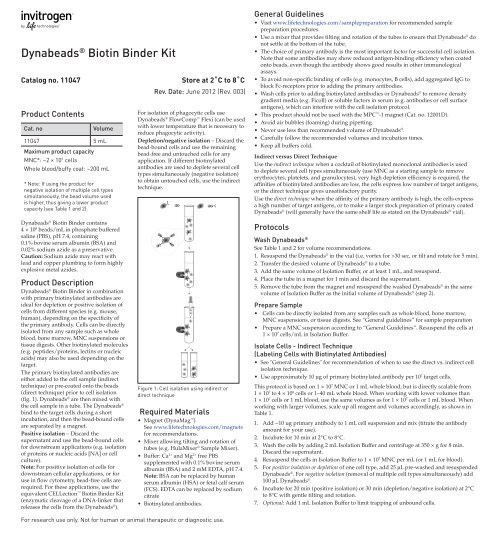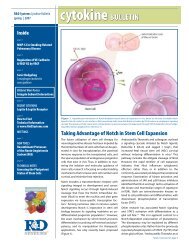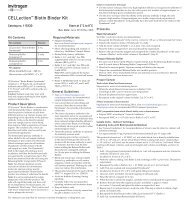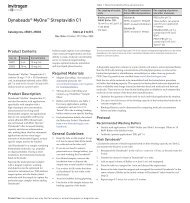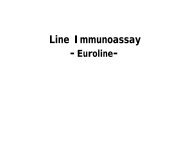Dynabeads Biotin Binder Kit
Dynabeads® Biotin Binder Kit
Dynabeads® Biotin Binder Kit
Create successful ePaper yourself
Turn your PDF publications into a flip-book with our unique Google optimized e-Paper software.
<strong>Dynabeads</strong> ® <strong>Biotin</strong> <strong>Binder</strong> <strong>Kit</strong><br />
Catalog no. 11047<br />
Product Contents<br />
Cat. no<br />
Volume<br />
11047 5 mL<br />
Maximum product capacity<br />
MNC*: ~2 × 10 9 cells<br />
Whole blood/buffy coat: ~200 mL<br />
* Note: If using the product for<br />
negative isolation of multiple cell types<br />
simultaneously, the bead volume used<br />
is higher, thus giving a lower product<br />
capacity (see Table 1 and 2).<br />
<strong>Dynabeads</strong> ® <strong>Biotin</strong> <strong>Binder</strong> contains<br />
4 × 10 8 beads/mL in phosphate buffered<br />
saline (PBS), pH 7.4, containing<br />
0.1% bovine serum albumin (BSA) and<br />
0.02% sodium azide as a preservative.<br />
Caution: Sodium azide may react with<br />
lead and copper plumbing to form highly<br />
explosive metal azides.<br />
Product Description<br />
<strong>Dynabeads</strong> ® <strong>Biotin</strong> <strong>Binder</strong> in combination<br />
with primary biotinylated antibodies are<br />
ideal for depletion or positive isolation of<br />
cells from different species (e.g. mouse,<br />
human), depending on the specificity of<br />
the primary antibody. Cells can be directly<br />
isolated from any sample such as whole<br />
blood, bone marrow, MNC suspensions or<br />
tissue digests. Other biotinylated molecules<br />
(e.g. peptides/proteins, lectins or nucleic<br />
acids) may also be used depending on the<br />
target.<br />
The primary biotinylated antibodies are<br />
either added to the cell sample (indirect<br />
technique) or pre-coated onto the beads<br />
(direct technique) prior to cell isolation<br />
(fig. 1). <strong>Dynabeads</strong> ® are then mixed with<br />
the cell sample in a tube. The <strong>Dynabeads</strong> ®<br />
bind to the target cells during a short<br />
incubation, and then the bead-bound cells<br />
are separated by a magnet.<br />
Positive isolation – Discard the<br />
supernatant and use the bead-bound cells<br />
for downstream applications (e.g. isolation<br />
of proteins or nucleic acids [NA] or cell<br />
culture).<br />
Note: For positive isolation of cells for<br />
downstream cellular applications, or for<br />
use in flow cytometry, bead-free cells are<br />
required. For these applications, use the<br />
equivalent CELLection <strong>Biotin</strong> <strong>Binder</strong> <strong>Kit</strong><br />
(enzymatic cleavage of a DNA-linker that<br />
releases the cells from the <strong>Dynabeads</strong> ® ).<br />
Store at 2˚C to 8˚C<br />
Rev. Date: June 2012 (Rev. 003)<br />
For isolation of phagocytic cells use<br />
<strong>Dynabeads</strong> ® FlowComp Flexi (can be used<br />
with lower temperature that is necessary to<br />
reduce phagocytic activity).<br />
Depletion/negative isolation – Discard the<br />
bead-bound cells and use the remaining<br />
bead-free and untouched cells for any<br />
application. If different biotinylated<br />
antibodies are used to deplete several cell<br />
types simultaneously (negative isolation)<br />
to obtain untouched cells, use the indirect<br />
technique.<br />
Figure 1: Cell isolation using indirect or<br />
direct technique<br />
Required Materials<br />
• Magnet (DynaMag )<br />
See www.lifetechnologies.com/magnets<br />
for recommendations.<br />
• Mixer allowing tilting and rotation of<br />
tubes (e.g. HulaMixer ® Sample Mixer).<br />
• Buffer: Ca 2+ and Mg 2+ free PBS<br />
supplemented with 0.1% bovine serum<br />
albumin (BSA) and 2 mM EDTA, pH 7.4.<br />
Note: BSA can be replaced by human<br />
serum albumin (HSA) or fetal calf serum<br />
(FCS). EDTA can be replaced by sodium<br />
citrate<br />
• <strong>Biotin</strong>ylated antibodies.<br />
General Guidelines<br />
• Visit www.lifetechnologies.com/samplepreparation for recommended sample<br />
preparation procedures.<br />
• Use a mixer that provides tilting and rotation of the tubes to ensure that <strong>Dynabeads</strong> ® do<br />
not settle at the bottom of the tube.<br />
• The choice of primary antibody is the most important factor for successful cell isolation.<br />
Note that some antibodies may show reduced antigen-binding efficiency when coated<br />
onto beads, even though the antibody shows good results in other immunological<br />
assays.<br />
• To avoid non-specific binding of cells (e.g. monocytes, B cells), add aggregated IgG to<br />
block Fc-receptors prior to adding the primary antibodies.<br />
• Wash cells prior to adding biotinylated antibodies or <strong>Dynabeads</strong> ® to remove density<br />
gradient media (e.g. Ficoll) or soluble factors in serum (e.g. antibodies or cell surface<br />
antigens), which can interfere with the cell isolation protocol.<br />
• This product should not be used with the MPC -1 magnet (Cat. no. 12001D).<br />
• Avoid air bubbles (foaming) during pipetting.<br />
• Never use less than recommended volume of <strong>Dynabeads</strong> ® .<br />
• Carefully follow the recommended volumes and incubation times.<br />
• Keep all buffers cold.<br />
Indirect versus Direct Technique<br />
Use the indirect technique when a cocktail of biotinylated monoclonal antibodies is used<br />
to deplete several cell types simultaneously (use MNC as a starting sample to remove<br />
erythrocytes, platelets, and granulocytes), very high depletion efficiency is required, the<br />
affinities of biotinylated antibodies are low, the cells express low number of target antigens,<br />
or the direct technique gives unsatisfactory purity.<br />
Use the direct technique when the affinity of the primary antibody is high, the cells express<br />
a high number of target antigens, or to make a larger stock preparation of primary coated<br />
<strong>Dynabeads</strong> ® (will generally have the same shelf life as stated on the <strong>Dynabeads</strong> ® vial).<br />
Protocols<br />
Wash <strong>Dynabeads</strong> ®<br />
See Table 1 and 2 for volume recommendations.<br />
1. Resuspend the <strong>Dynabeads</strong> ® in the vial (i.e. vortex for >30 sec, or tilt and rotate for 5 min).<br />
2. Transfer the desired volume of <strong>Dynabeads</strong> ® to a tube.<br />
3. Add the same volume of Isolation Buffer, or at least 1 mL, and resuspend.<br />
4. Place the tube in a magnet for 1 min and discard the supernatant.<br />
5. Remove the tube from the magnet and resuspend the washed <strong>Dynabeads</strong> ® in the same<br />
volume of Isolation Buffer as the initial volume of <strong>Dynabeads</strong> ® (step 2).<br />
Prepare Sample<br />
• Cells can be directly isolated from any samples such as whole blood, bone marrow,<br />
MNC suspensions, or tissue digests. See “General guidelines” for sample preparation<br />
• Prepare a MNC suspension according to “General Guidelines”. Resuspend the cells at<br />
1 × 10 7 cells/mL in Isolation Buffer.<br />
Isolate Cells - Indirect Technique<br />
(Labeling Cells with <strong>Biotin</strong>ylated Antibodies)<br />
• See "General Guidelines" for recommendation of when to use the direct vs. indirect cell<br />
isolation technique.<br />
• Use approximately 10 μg of primary biotinylated antibody per 10 7 target cells.<br />
This protocol is based on 1 × 10 7 MNC or 1 mL whole blood, but is directly scalable from<br />
1 × 10 7 to 4 × 10 8 cells or 1–40 mL whole blood. When working with lower volumes than<br />
1 × 10 7 cells or 1 mL blood, use the same volumes as for 1 × 10 7 cells or 1 mL blood. When<br />
working with larger volumes, scale up all reagent and volumes accordingly, as shown in<br />
Table 1.<br />
1. Add ~10 ug primary antibody to 1 mL cell suspension and mix (titrate the antibody<br />
amount for your use).<br />
2. Incubate for 10 min at 2°C to 8°C.<br />
3. Wash the cells by adding 2 mL Isolation Buffer and centrifuge at 350 × g for 8 min.<br />
Discard the supernatant.<br />
4. Resuspend the cells in Isolation Buffer to 1 × 10 7 MNC per mL (or 1 mL for blood).<br />
5. For positive isolation or depletion of one cell type, add 25 µL pre-washed and resuspended<br />
<strong>Dynabeads</strong> ® . For negative isolation (removal of multiple cell types simultaneously) add<br />
100 µL <strong>Dynabeads</strong> ® .<br />
6. Incubate for 20 min (positive isolation) or 30 min (depletion/negative isolation) at 2°C<br />
to 8°C with gentle tilting and rotation.<br />
7. Optional: Add 1 mL Isolation Buffer to limit trapping of unbound cells.<br />
For research use only. Not for human or animal therapeutic or diagnostic use.
8. Place the tube in a magnet for 2 min.<br />
9. Negative isolation/depletion: Transfer the supernatant containing the unbound cells to a<br />
fresh tube for further experiments.<br />
or<br />
Positive isolation: While the tube is still in the magnet, carefully remove and discard the<br />
supernatant.<br />
10. Remove the tube from the magnet and add 1 mL Isolation Buffer, pipet 2–3 times<br />
(or vortex 2–3 sec) and place the tube in a magnet for 2 min.<br />
11. Repeat steps 9–10 at least twice to wash the cells and obtain high purity.<br />
12. Resuspend the cell pellet in preferred cell medium.<br />
Table 1: Volumes for indirect cell isolation.<br />
Step Step description Volumes per<br />
1 × 10 7 MNC<br />
Volumes per<br />
2 × 10 8 MNC<br />
Recommended tube size 5–7 mL 50 mL<br />
Recommended magnet DynaMag -5 DynaMag -50<br />
1 Primary biotinylated antibody ~10 μg ~200 μg<br />
1 Cell volume (MNC/blood) 1 mL 20 mL<br />
3* Wash cells (Isolation Buffer) ~2 mL ~40 mL<br />
4 Resuspend cells 1 mL 20 mL<br />
5**(*) Add <strong>Dynabeads</strong> ®<br />
(positive isolation/depletion)<br />
Add <strong>Dynabeads</strong> ® (negative isolation)<br />
25 μL<br />
100 μL<br />
500 μL<br />
2 mL<br />
7* Increase volume (Isolation Buffer) ~1 mL ~ 20 mL<br />
10–12* For positive isolation only:<br />
Wash cells (Buffer 1)<br />
3 × ~1 mL 3 × 20 mL<br />
* Adjust the Isolation Buffer volumes to fit to the tube you are using.<br />
** If very high depletion efficiency is required or you are depleting many cells simultaneously, you might<br />
have to increase/ optimize the amount of <strong>Dynabeads</strong> ® .<br />
*** When incubating, tilt and rotate so the cells and beads are kept in the bottom of the tube.<br />
Do not perform end-over-end mixing if the volume is small relative to the tube size.<br />
Isolate Cells – Direct Technique (Antibody-coating of <strong>Dynabeads</strong> ® )<br />
• See "General Guidelines" for recommendation of when to use the direct vs. indirect cell<br />
isolation technique.<br />
• Use 0.5–1.5 μg of primary biotinylated antibody per 25 μL (1 × 10 7 ) <strong>Dynabeads</strong> ® . Titrate<br />
the primary antibody to optimize the amount used.<br />
This protocol is based on 1 × 10 7 MNC or 1 mL whole blood, but is directly scalable from<br />
1 × 10 7 to 4 × 10 8 cells or 1–40 mL whole blood. When working with lower volumes than<br />
1 × 10 7 cells or 1 mL blood, use the same volumes as for 1 × 10 7 cells or 1 mL blood. When<br />
working with larger volumes, scale up all reagent and volumes accordingly, as shown in<br />
Table 2.<br />
1. Transfer 25 µL pre-washed and resuspended <strong>Dynabeads</strong> ® to a tube.<br />
2. Add ~1 ug antibodies (titrate the antibody amount for your use).<br />
3. Incubate for ≥30 minutes at room temperature with gentle tilting and rotation.<br />
4. Place the tube in a magnet for 1 min and discard the supernatant.<br />
5. Remove the tube from the magnet and add 2 mL Isolation Buffer.<br />
6. Repeat steps 4–5 once to remove excess of antibodies.<br />
7. Place the tube in the magnet for 1 min and discard the supernatant.<br />
8. Add to the beads to 1 mL cell sample (blood or 1 × 10 7 MNC) and resuspend.<br />
9. Incubate for 20 min (positive isolation) or 30 min (depletion) at 2°C to 8°C with gentle<br />
tilting and rotation<br />
10. Optional: Add 1 mL Isolation Buffer to limit trapping of unbound cells.<br />
11. Place the tube in a magnet for 2 min.<br />
12. Depletion: Transfer the supernatant containing the unbound cells to a fresh tube for<br />
further experiments.<br />
or<br />
Positive isolation: While the tube is still in the magnet, carefully remove and discard the<br />
supernatant.<br />
13. Remove the tube from the magnet and add 1 mL Isolation Buffer, pipet 2–3 times<br />
(or vortex 2–3 sec) and place the tube in a magnet for 2 min.<br />
14. Repeat steps 12–13 at least twice to wash the cells and to obtain high purity.<br />
15. Resuspend the cell pellet in preferred cell medium.<br />
Table 2: Volumes for direct cell isolation.<br />
Step Step description Volumes per<br />
1 × 10 7 MNC<br />
Description of Materials<br />
<strong>Dynabeads</strong> ® <strong>Biotin</strong> <strong>Binder</strong> are uniform, superparamagnetic polystyrene beads (4.5 μm<br />
diameter) coated with with recombinant streptavidin. The streptavidin coated onto<br />
<strong>Dynabeads</strong> ® will bind most biotinylated ligands. Unwanted binding of cells to streptavidin<br />
via lectin-like receptors or other adhesive receptors is avoided since the recombinant<br />
streptavidin contains neither sugar nor the RYD sequence.<br />
Related Products<br />
Product<br />
DynaMag -5<br />
DynaMag -15<br />
DynaMag -50<br />
<strong>Dynabeads</strong> ® FlowComp Flexi<br />
CELLection <strong>Biotin</strong> <strong>Binder</strong><br />
HulaMixer ® Sample Mixer<br />
REF<br />
on labels is the symbol for catalog number.<br />
Limited Use Label License<br />
The purchase of this product conveys to the purchaser the limited, nontransferable right to use<br />
the purchased amount of the product only to perform internal research for the sole benefit of<br />
the purchaser. No right to resell this product or any of its components is conveyed expressly, by<br />
implication, or by estoppel. This product is for internal research purposes only and is not for<br />
use in commercial applications of any kind, including, without limitation, quality control and<br />
commercial services such as reporting the results of purchaser’s activities for a fee or other form<br />
of consideration. For information on obtaining additional rights, please contact outlicensing@<br />
lifetech.com or Out Licensing, Life Technologies, 5791 Van Allen Way, Carlsbad, California 92008.<br />
Manufactured by Life Technologies AS, Norway. Life Technologies AS complies with the Quality<br />
System Standards ISO 9001:2008 and ISO 13485:2003.<br />
Limited Product Warranty<br />
Life Technologies Corporation and/or its affiliate(s) warrant their products as set forth in the<br />
Life Technologies' General Terms and Conditions of Sale found on Life Technologies' website at<br />
www.lifetechnologies.com/termsandconditions. If you have any questions, please contact Life<br />
Technologies at www.lifetechnologies.com/support.<br />
©2012 Life Technologies Corporation. All rights reserved. The trademarks mentioned herein are the property of Life<br />
Technologies Corporation and/or its affiliate(s) or their respective owners.<br />
Life Technologies CORPORATION and/or its affiliate(s) disclaim all warranties with respect to this<br />
document, expressed or implied, including but not limited to those of merchantability or fitness<br />
for a particular purpose OR NON-INFRINGEMENT. TO THE EXTENT ALLOWED BY LAW, In no event shall Life<br />
Technologies and/or its affiliate(s) be liable, whether in contract, tort, warranty, or under any<br />
statute or on any other basis for special, incidental, indirect, punitive, multiple or consequential<br />
damages in connection with or arising from this document, including but not limited to the use<br />
thereof.<br />
For support visit www.lifetechnologies.com/support or<br />
email techsupport@lifetech.com<br />
www.lifetechnologies.com<br />
Cat. no.<br />
12303D<br />
12301D<br />
12302D<br />
11061D<br />
11533D<br />
15920D<br />
Volumes per<br />
2 × 10 8 MNC<br />
Recommended tube size 5–7 mL 50 mL<br />
Recommended magnet DynaMag -5 DynaMag -50<br />
1 <strong>Dynabeads</strong> ® 25 μL 500 μL<br />
2 Primary biotinylated antibody ~1 ug ~20 ug<br />
5-6 Wash <strong>Dynabeads</strong> ® (Isolation Buffer) 2 x ~2 mL 2 x ~40 mL<br />
8 Cell volume 1 mL 20 mL<br />
10* Optional: Increase volume<br />
~1 mL ~8 mL<br />
(Isolation Buffer)<br />
13-14* For positive isolation only:<br />
Wash the cells (Isolation Buffer) 3 × ~1 mL 3× 20 mL<br />
* Adjust the Buffer volumes to fit to the tube you are using.<br />
** If the target cell population is high (e.g. >2.5 × 10 6 target cells/mL), increase/double the amount of<br />
<strong>Dynabeads</strong> ® .<br />
*** When incubating, tilt and rotate so the cells and beads are kept in the bottom of the tube.<br />
Do not perform end-over-end mixing if the volume is small relative to the tube size.<br />
SPEC-05724


